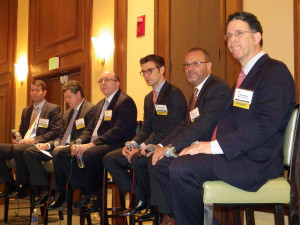For 200-plus businesspeople, many in the commercial real estate and development arenas, the future of Westchester and Fairfield counties was laid out as clearly as prognostication will allow recently at a breakfast in the grand ballroom of Hilton Stamford Hotel & Executive Meeting Center.
Both the real estate data and the mood were upbeat, a champagne moment amid the coffee and orange juice that stood in contrast to the downturn-fueled morbidity of real estate”™s recent past. If a person arrived looking for a run of the bulls, it was there. One panelist professed hope for a three- to four-year era of black ink.
The event ”” titled “The Future of Westchester and Fairfield Counties” ”” was produced by Washington, D.C.-based Bisnow Media.
“If you have a good location and good amenities, the market is good,” said panelist Jeff Newman, executive vice president, Malkin Properties. He noted new commercial deals remained low and early renewals were down, “largely because they already did it.” But, he said, “It”™s a heck of a lot better than it was a couple of years ago.”

The remaining panelists were Brett Wilderman, principal, Forstone Capital; John Barnes, senior vice president and managing director, Reckson division of S.L. Green Realty Corp.; Jose Cruz, senior managing director, Holliday Fenoglio Fowler L.P.; Jeremy Leventhal, managing partner, Faros Properties; and Alex Argento, senior vice president and director of operations, Vidaris Inc. Steve Kirn, partner for Northeast construction, McGladrey, moderated.
Said Wilderman: “In Fairfield County the deal flow is light. Leasing is slow, but getting better. The leverage is still on the tenant”™s side in lease negotiations. As far as investors are concerned, a lot are coming off the sidelines.”
Wilderman tagged himself an optimist, as did several panel members, and said, “I think the market will improve. I don”™t see things getting worse; I see them getting better. We have a bullish attitude across the next three to four years.”
Cruz, too, saw the uptick in investor activity. “We are now seeing capital arrive from outside the market,” he said.
Levanthal took the assembled to the 1950s, when the large suburban picture emerged, fed by highways, houses and office parks. He called the ”™50s, ”™60s and ”™70s “the heyday of the markets.” The suburbs then received a boost from New York City”™s late-century crime woes, he said. Now, there is a net migration back to cities by the so-called Generation Y. When all of that is factored, he said, Westchester residents now average five to six years older than New York City residents.
Therein lies a rub. “The existing blue chips don”™t create jobs,” he said. “They are net job destroyers. It”™s the startups begun by these entrepreneurs under 30 years old that create jobs.” Cycles persist, however, and “I see them coming back,” Leventhal said.
Newman said, “At some point Generation Y will have kids. They can”™t all afford to send their kids to private schools. Going forward, hopefully we”™ll see more people opening offices up this way.”
The market rebound comes with green baggage that could prove permanent. “Sustainability has become a passion because it has become a necessity,” Barnes said. “You have to make sure you are the most efficient to be the most competitive.”
“From architecture to engineering, understanding the financial drivers of being green is important,” Argento said. “There”™s some bling there. The idea now is getting finance and tax professionals involved with the design and architecture teams. What tax breaks can we go after on the state and federal levels? What roof should I put on my property? What can I do to distinguish my property? The focus is on payback.”
The recent surge in interest rates ”” 1 to 1.2 percent in the last two months ”” did not go unnoticed. “Rates are still at historic lows,” Leventhal said. “But some people have not gotten used to the new rise.”
Several panelists noted tight inventories are bumping against restless investment money. “The dark cloud on the horizon is interest rates, but it looks like smooth sailing now,” Cruz said. “We are now seeing bidding wars. There is not enough product for the investment community.”
Leventhal agreed, saying, “Cheap credit and a lot of equity are driving prices up.”
As the give and take wandered from commercial real estate to the buoyant housing market ”” multifamilies remain among the hottest properties ”” the region”™s infrastructure also arose as a topic. There was general enthusiasm for the new Tappan Zee Bridge, with Barnes calling the current, 1950s incarnation “an absolute disaster.”
Newman offered a pair of anecdotes to drive home the need for continued investment of the sort at the Tappan Zee Bridge remake. He alighted from his New Haven line commuter train May 17 two minutes before it derailed; and on June 28, 1983, he drove one of the last cars to clear the Mianus River bridge on I-95 before it collapsed.
Sponsors included Vidaris Inc.; McGladrey L.L.P.; Holliday Fenoglio Fowler (HFF) L.P.; NAI Freidland Commercial Real Estate Services; and marketing partner Co-Communications.


















